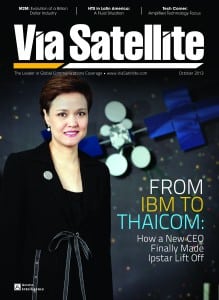Via Satellite October: 10 Best Quotes
 In our October issue of Via Satellite magazine we offer you an exclusive interview with Thaicom’s CEO, Suphajee Suthumpun, exploring the challenges and opportunities she faced when taking over the operator and her success with Ipstar. Also, we delve into the possibilities for satellite in the booming billion-dollar M2M industry, and we assess the impact HTS will have in a thriving Latin America.
In our October issue of Via Satellite magazine we offer you an exclusive interview with Thaicom’s CEO, Suphajee Suthumpun, exploring the challenges and opportunities she faced when taking over the operator and her success with Ipstar. Also, we delve into the possibilities for satellite in the booming billion-dollar M2M industry, and we assess the impact HTS will have in a thriving Latin America.
Additionally, as a digital edition exclusive, we interview Donald Happel, field telecoms advisor, Americas Infrastructure Projects, Shell Information Technology International, to discuss the oil and gas market, highlighting the potential need for HTS communications and the capabilities it could bring to this industry.
As a teaser for this new issue, these are the top 10 quotes from Via Satellite magazine’s October 2013 issue:
As technology costs drop, you’ll see more business and consumer applications surface. This market is similar to the Internet. As people become accustomed to having easy access to information, it created a demand for more applications and capabilities. We are seeing a similar shift in the satellite domain – users demanding the ability to stay connected and send more data, faster.
Dan Poirier, senior vice president of operations, SkyWave Mobile Communications.
Our research showed that in Brazil and Mexico there is a potential demand of millions of households for residential satellite broadband services. When you combine the expected pace of deployment of other terrestrial broadband networks with the expected increase of many population groups that today cannot afford these services but will in the coming years, the result is that millions of households are potentially customers. We see a strong demand over the next decade.
Ignacio Sanchis, chief commercial officer, Hispasat
Unlike the experiences in the United States and Europe, demand for high throughput satellite capacity in Latin America could be rather driven by a mix of consumer-class and enterprise-class services but with a stronger enterprise play. There are strong roots for enterprise VSAT services in the region, which will gradually migrate toward HTS services as capacity becomes available.
Carlos Placido, analyst, NSR
[In Latin America] There are also strong opportunities in maritime, energy, mining, hospitality, retail, health care and manufacturing – with double digital growth rates expected. This demand will be aided by government-funded projects throughout the region aimed at bridging the digital divide, a loosening of foreign direct investment regulations and telecom industry deregulation.
Rob Kilroy, vice-president of sales in Americas, iDirect
We would like to see 80 percent of our revenues coming from satellite services. We want to focus on growing the company as a satellite service provider. We will focus on our core operations and do a bit more portfolio management, so we will keep a close eye on our other operations, and if we feel that they are not really making great contributions to us, then we may exit from those operations. We will focus on the growth parts of the business, and particularly the satellite business
Suphajee Suthumpun, CEO, Thaicom
There are certainly needs for video and we have chiefly met those needs using highly compressed video. It is very challenging to meet high-resolution video requirements at a cost-effective price. This could be an area where the new high-bandwidth Ka satellites bring new capabilities.
Donald Happel, field telecoms advisor, Americas Infrastructure Projects, Shell Information Technology International
Operators cannot ignore India’s significant commercial draws: continued growth of the Indian TV broadcasting and mobile backhaul sectors, along with the global increase of maritime and aero mobility services.
Nina Beebe, director for emerging markets, Access Partnership
Satcom has always had a lot of video distribution and broadcast because of the one-way nature of it, but now there is much more real-time, on-demand and even two-way video services being carried. … End users are demanding more video and that demand ultimately translates into amplifiers that can deliver higher power at higher frequencies.
Heidi Thelander, director, business development, Comtech Xicom.
Gallium Nitride allows single transistors to reach higher powers than those based Gallium Arsenide. The improvement is roughly a factor of five and Gallium Nitride allows solid state amplifiers to go much higher in power. We are early in the adoption curve but increased commercialization of this new technology will have a huge impact on the market. We can now reach hundreds of Watts at Ka-band.
Michael DeLisio, CTO, Wavestream
GaN-based amplifiers close the performance gap between solid-state amplifiers and traveling wave tube amplifiers (TWTA). GaN-based amplifiers offer the lowest cost of ownership, with the lowest capital cost, and the lowest operating cost. It might be another 20 or 30 years before there is a breakthrough of this magnitude. GaN technology continues to progress and improve. There maybe something that comes along better than GaN but I doubt it will be in our professional lives
David Gelerman, CEO, Advantech Wireless